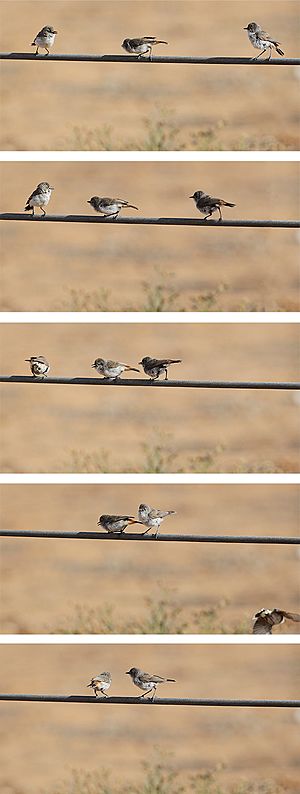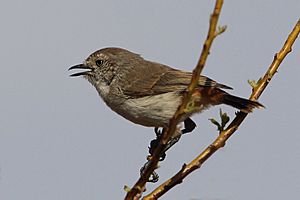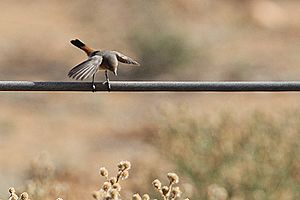Chestnut-rumped thornbill facts for kids
Quick facts for kids Chestnut-rumped thornbill |
|
|---|---|
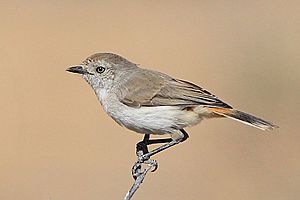 |
|
| At Mount Wood, Sturt Desert, NSW | |
| Conservation status | |
| Scientific classification | |
| Genus: |
Acanthiza
|
| Species: |
uropygialis
|
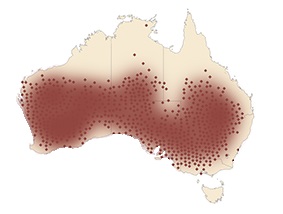 |
|
The chestnut-rumped thornbill (Acanthiza uropygialis) is a small bird that lives only in Australia. It's part of a bird family called Acanthizidae.
It gets its name from its pale chestnut-colored rump (the area above its tail). The word uropygium comes from old Latin and means 'rump'. People sometimes call it the chestnut-tailed thornbill or chestnut-backed thornbill.
This plain, pale bird has light-colored eyes. It is found across inland Australia, from west of the Great Dividing Range to the coast of Western Australia. However, you won't find it in the far north or the wet southwestern parts of WA. Like some other thornbills, it is a cooperative breeder, meaning more than just the parents help raise the young.
Contents
About the Chestnut-rumped Thornbill
How it Got its Name
The chestnut-rumped thornbill was first described and named by a scientist named John Gould in 1838. He wrote about it in his book, Synopsis of Birds of Australia. The first bird he studied was found in Liverpool Plains, New South Wales.
What Does it Look Like?
This thornbill is about 9.8 centimeters (around 4 inches) long. Its wingspan is about 15.5 centimeters, and it weighs around 6 grams.
It is a pale, plain bird with light-colored eyes. Its upper body is pale grey-brown, and it has a bright chestnut-colored rump. Its tail is mostly black with pale tips. The area around its ears is lightly speckled, and its forehead and crown have a reddish-brown tint. Its belly is plain whitish. Male and female birds look the same, and their appearance doesn't change with the seasons.
Birds living in drier inland areas tend to be paler and greyer. They also have a slightly lighter rump patch and whiter undersides compared to those near the coast.
These birds are usually found in small groups of two or three. Sometimes they join other thornbills or small birds. They are active and always moving. Chestnut-rumped thornbills look for food in shrubs and trees. They quickly hop and flit through leaves and low branches, poking into cracks in bark. They also hop on the ground, searching among fallen leaves and twigs.
Their flight is like other thornbills, moving quickly from one hiding spot to another in low, wavy dashes. Their song is strong and can be heard from far away. They can also copy the calls of other birds.
Young thornbills look similar to adults. However, their head patterns are duller, and their tail tips are pale buff instead of white. Their eyes are also a duller cream or greyish-white.
Where Do They Live?
These birds live only on the mainland of Australia.
- Queensland: You can find them widely in the southern parts, west of the Great Dividing Range.
- New South Wales & ACT: They are common west of the Great Divide, including the western slopes of the Northern and Southern Tablelands, and near Canberra.
- Victoria: They are widespread in the Mallee, Wimmera, and North Districts.
- South Australia: They are found in many regions, but usually not in the southeast.
- Western Australia: They are mostly absent from the Nullarbor Plain. Farther west, they are widespread in areas from the Pilbara region down to the Gibson and Great Victoria Deserts.
Do They Move Around?
Chestnut-rumped thornbills usually stay in the same area. However, some individuals might move long distances. Large groups that are not breeding will spread out before it's time to lay eggs.
What Kind of Places Do They Like?
They prefer dry woodlands and shrublands. These areas often have mulga trees and malleeeucalypts. They also live in thickets, areas with saltbush or bluebush, and open farmland. You might see them among dead trees and stumps.
They can be found in many different landscapes, including sand dunes, flood plains, rocky hillsides, and gorges.
How Do They Behave?
What Do They Eat?
Chestnut-rumped thornbills mainly eat insects. Sometimes, they will also eat seeds. Studies of their stomach contents have shown spiders, insects, plants, seeds, and buds.
They usually find food by picking it off leaves and branches of shrubs and low trees. They also regularly search for food on the ground. They will poke into bark cracks to find hidden insects. Young birds are fed tiny insects and small white grubs.
These birds are social and are rarely seen alone. They usually feed in small groups of up to ten birds, sometimes up to 20. They often feed with other birds like brown thornbills, yellow-rumped thornbills, southern whitefaces, white-browed scrubwrens, or redthroats. Sometimes, silvereyes join them too.
In South Australia during winter, they might gather in large mixed groups with other thornbills, sometimes with 100 or more birds!
How Do They Raise Their Young?
Most of the time, chestnut-rumped thornbills breed in pairs. However, they sometimes breed co-operatively, meaning other birds help the parents raise the chicks.
The breeding season is from June to December. They can raise two, and sometimes even three, groups of young each season. The eggs are laid every two days. They are small, slightly shiny, and a flesh-white color. They have tiny reddish-brown and purplish-brown speckles, especially at the larger end.
Nests are usually built inside hollows, often vertical ones, in live or dead trees. The entrance is often at the end of a spout, a crack, or a knothole in the side of a branch or trunk. They also nest in stumps, logs on the ground, and fence posts.
The chicks are born helpless and stay in the nest. Both parents feed the young birds until they are ready to fly, which takes about 18–20 days.
Both adult birds help build the nest. The nests are small, neat, and shaped like a dome, usually oval. They have a round entrance on the side or near the top. If the nest is inside a hollow, the entrance is often flush with the opening of the hollow. They use dried grass, bark strips, plant stems, moss, lichen, and spider webs to build the nest. They line it with feathers, wool, or fur.
Sometimes, Horsfield's bronze cuckoos lay their eggs in the nests of chestnut-rumped thornbills, tricking the thornbills into raising their chicks.
Are They Safe?
The chestnut-rumped thornbill lives across a very large area. Because of this, it is not considered to be in danger of disappearing. Its population is decreasing, but not quickly enough to be a major concern. The total number of these birds has not been counted, but it is believed to be large enough. For these reasons, scientists say the species is of "least concern."
However, the chestnut-rumped thornbill is on a list of woodland birds that are declining. These birds often feed and live on the ground or in low shrubs and mainly eat insects. When woodlands are cleared for farming and remaining plants are overgrazed by animals, there are fewer insects on the ground. This might be causing the chestnut-rumped thornbill's living area to shrink towards the drier inland parts of Australia.
Images for kids
See also
 In Spanish: Acantiza culirroja para niños
In Spanish: Acantiza culirroja para niños



